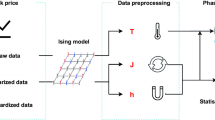Abstract
This paper studies computational stock market by using network model and similar methodology used in solid mechanics. Four simultaneous basic equations, i.e., equation of interest rate and amount of circulating fund, equations of purchasing and selling of share, equation of changing rate of share price, and equation of interest rate, share price and its changing rate, have been established. Discussions mainly on the solution and its simple applications of the equation of interst rate and amount of circulating fund are given. The discussions also involve the proof of tending to the equilibrium state of network of stock market based on the time discrete form of the equation by using Banach theorem of contraction mapping and the influence of amount of circulating fund with exponential attenuation due to the decreasing of banking interest rate.
Similar content being viewed by others
References
Amir Rabah. Sensitivity analysis of multisector optimal economic dynamics [J].J Math. Econom, 1996,25:123–141
Wai Mun Fung, Ouliaris Sam. Spectral tests of the Martingale hypothesis for exchange rates [J].J Appl Econometrics, 1995,10:255–271
Li Jie, Wang Wenjun, Liu Xianhui, et al.Analysis Forward Price [M]. Bejing. Beijing Industrial University Publisher, 1994, 46–64 (in. Chinese)
Chang Rongqing.88 Methods for win, in Stock Market [M]. Beijing: China Economic Publishers, 1993, 1–183 (in Chinese)
Zheng Haitai. 183 Secrets of Success in Stock Market Fighting [M]. Beijing: Economic Publishers, 1992 (in Chinese)
Clarkson T G. Introduction to neural networks [J].Neural Network World, 1996,6(2): 123–130
Yagawa G. Finite elements with network mechanism [A]. In: Tadahiko Kawai ed.WCCM 3[C], Vol.2, IACM, Chiba, Japan, 1994, 1474–1481
Kuan C M, Liu T. Forecasting exchange rates using feed forward and recurrent neural networks [J].J Appl. Econom, 1995,10:347–364
Dunis C L. The economic. value of neural network systems for exchange rate forecasting [J].Neural Network World, 1996,6(1):43–55
Baptist G, Lin F C, Nelson J, Jr, Note on the long term trend of the Dow Jones Industrial Average [J].Neural Network World, 1996,6(3): 259–262
Yun Tianquan.Integral Equations and Its Applications in Mechanics [M]. Guangzhou: South China University of Technology Publishers, 1990, 232–234 (in Chinese)
Yun Tianquan. A basic integro-differential equation of RCPS [J].J South, China University of Technology, 1996,24 (6):35–39 (in Chinese)
Yun Tianquan. Short-range forecasting of stock price in normal case [J].J South China University of Technology, 1997,25(5):47–51 (in Chinese)
Author information
Authors and Affiliations
Rights and permissions
About this article
Cite this article
Tianquan, Y. Basic equations, theory and principle of computational stock market (I) —Basic equations. Appl Math Mech 20, 154–162 (1999). https://doi.org/10.1007/BF02481894
Received:
Issue Date:
DOI: https://doi.org/10.1007/BF02481894




